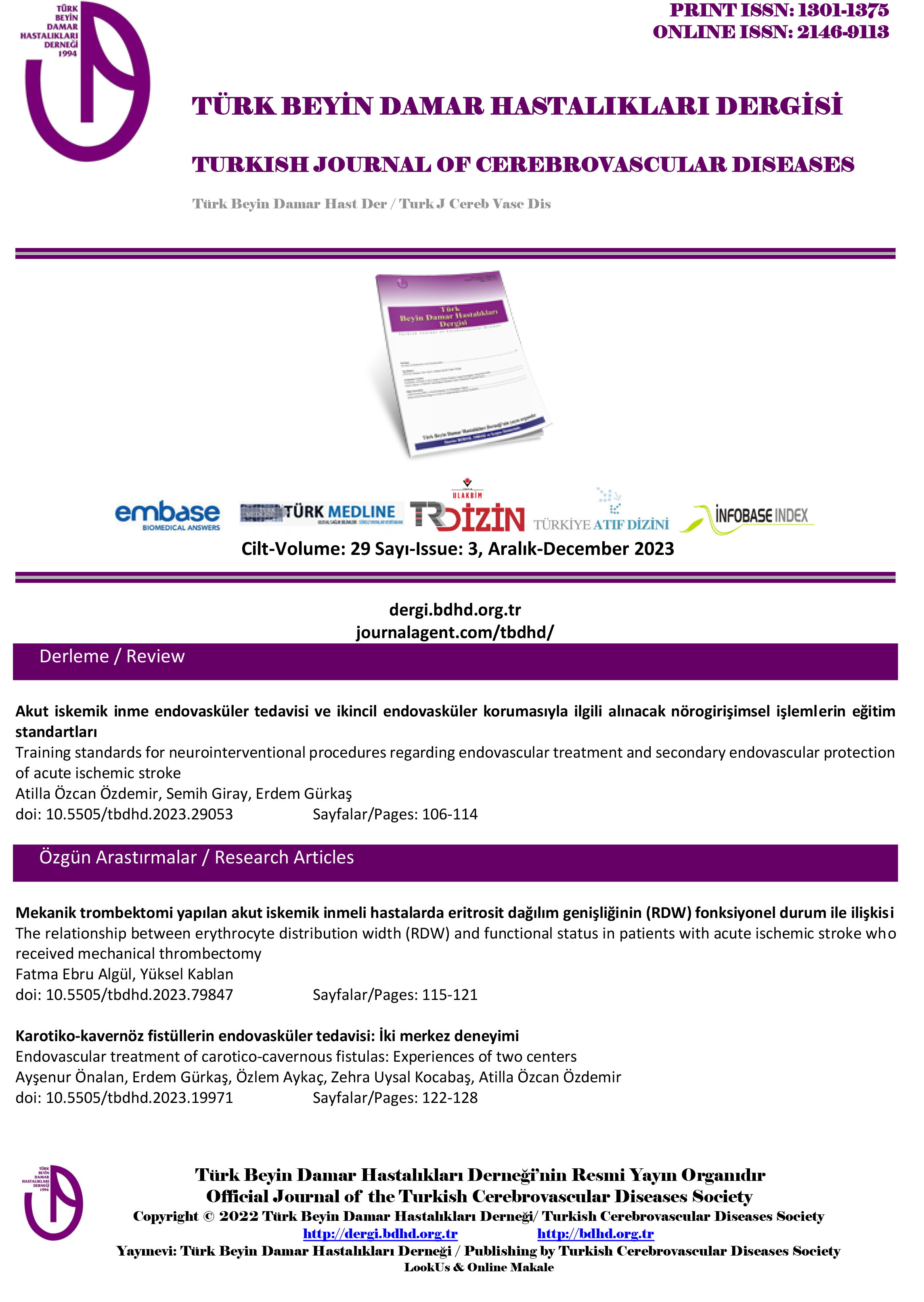COVID-19 pandemisi döneminde akut inme yönetimi
Murat Polat, Baki DoğanOndokuz Mayıs Üniversitesi Tıp Fakültesi, Nöroloji Anabilim Dalı, SamsunGİRİŞ ve AMAÇ: Koronavirus hastalığı 2019 (COVID-19) pandemisinde akut inme başvurularında ve akut tedavi sayılarında azalma ve tedavi sürelerinde gecikmeler yaşanabilmektedir. Bu çalışmada COVID-19 pandemisinde ve pandemi öncesi dönemde akut inme ile başvuran hastaların klinik özelliklerinin karşılaştırılması amaçlanmıştır.
YÖNTEM ve GEREÇLER: Çalışmaya 01 Ocak 2019 ve 31 Mayıs 2021 tarihleri arasında beyin damar hastalığı (BDH) tanısıyla yatırılan hastalar alınmıştır. Hastaların demografik özellikleri ve inme risk faktörleri kaydedilmiştir. İnme şekli ve iskemik BDH subtipleri belirlenerek hastaların başvuru National Institutes Of Health Stroke Scale (NIHSS) skoru, semptom-kapı zamanı, kapı-konsultasyon zamanı, intravenöz doku tipi plazminojen aktivatörü (IV tPA) ve endovasküler trombektomi (EVT) uygulanma sayıları, kapı-iğne zamanı ve kapı kasık zamanı kaydedilmiştir. Taburculuk modifiye Rankin Skalası (mRS) ve NIHSS skorları ve mortalite oranları değerlendirilmiştir. 14er aylık iki ayrı periyotta yatırılan hastalar pandemi öncesi ve pandemi dönemi olarak ikiye ayrılarak karşılaştırılmıştır.
BULGULAR: COVID-19 öncesi 316 (kadın %45,25, yaş: 66,75±13,68 yıl), pandemi döneminde ise 341 (kadın %41,94, yaş: 68,34±13,55 yıl) hasta çalışmaya dahil edilmiştir. Pandemi döneminde hemorajik BDH ve geçici iskemik atak sayılarında artma, iskemik inme ve serebral venöz tromboz (SVT) yatış sayılarında azalma, iskemik BDH subtiplerinde ise kardiyoembolik inmelerde azalma, lakünlerde artma gözlenmiştir (p<0,01). Büyük damar aterosklerozu, IV tPA ve EVT sayıları pandemi öncesi ve sonrasında benzer bulunmuştur. Pandemi döneminde, pandemi öncesi döneme göre istatiksel anlamlılığa ulaşmasa da semptom-kapı, kapı-konsültasyon, kapı-iğne ve kapı-kasık sürelerinde uzama kayıtlanmıştır(p>0,05). Pandemi döneminde yatan 5 iskemik inme hastasında (%1,8) yatıştan sonra COVID-19 testi pozitif çıkmıştır. Pandemi döneminde hemorajik ve iskemik inme hastaları arasında başvuru NIHSS, taburculuk NIHSS ve mRS skorları ve mortalite oranları anlamlı olarak daha yüksek bulunmuştur (p<0,01).
TARTIŞMA ve SONUÇ: COVID-19 pandemisi akut inme yönetimini olumsuz olarak etkilemektedir. Akut inme tedavi süresi hastane öncesi ve hastane içi sebeplerle gecikmektedir. Pandemi döneminde inme yükünün ağır olmasıyla birlikte kötü klinik sonlanım ve yüksek mortalite görülmektedir.
Acute stroke management during COVID-19 pandemic
Murat Polat, Baki DoğanOndokuz Mayıs University Medical Faculty, Department of Neurology, Samsun, TurkeyINTRODUCTION: In the coronavirus disease 2019 (COVID-19) pandemic, there may be a decrease in the number of acute stroke intervention and acute treatment, and delays in treatment periods. In this study, it was aimed to compare the clinical features of patients presenting with acute stroke during the COVID-19 pandemic and in the pre-pandemic period.
METHODS: Patients hospitalized with the diagnosis of cerebrovascular disease (CVD) between January 01, 2019 and May 31, 2021 were included in the study. Demographic characteristics and stroke risk factors of the patients were recorded. Stroke type and ischemic disease subtypes were determined, and patients' admission National Institutes of Health Stroke Scale (NIHSS) score, symptom-door time, door-consultation time, door-to-door Needle time and door-groin puncture time, intravenous tissue type plasminogen activator (IV tPA) and endovascular thrombectomy (EVT) applications were recorded. Discharge modified Rankin Scale (mRS) and NIHSS scores and mortality rates were evaluated. Patients hospitalized in two separate periods of 14 months each were compared by dividing them into pre-pandemic and pandemic periods.
RESULTS: RESULTS: Before COVID-19, 316 patients (female 45.25%, age: 66.75±13.68 years) and during the pandemic period 341 (female 41.94%, age: 68.34±13.55 years) patients were included in the study. During the pandemic period, an increase in the number of hemorrhagic CVD and transient ischemic attacks, a decrease in the number of ischemic stroke and cerebral venous thrombosis (CVT) hospitalizations, a decrease in cardioembolic strokes and an increase in lacuner ischemic CVD subtypes were observed (p<0.01). The number of large vessel atherosclerosis, IV tPA and EVT were found to be similar before and after the pandemic. In the pandemic period, although it did not reach statistical significance compared to the pre-pandemic period, prolongation was recorded in the symptom-door, door-consultation, door-needle and door-groin puncture times (p>0.05). The COVID-19 test was positive after hospitalization in 5 (1.8%) patients with ischemic stroke hospitalized during the pandemic period. During the pandemic period, admission NIHSS, discharge NIHSS and mRS scores and mortality rates were found to be significantly higher between hemorrhagic and ischemic stroke patients (p<0.01).
DISCUSSION AND CONCLUSION: The COVID-19 pandemic adversely affects the management of acute stroke. The duration of acute stroke treatment is delayed due to pre-hospital and in-hospital reasons. With the heavy burden of stroke during the pandemic period, poor clinical outcome and high mortality are observed.
Sorumlu Yazar: Murat Polat, Türkiye
Makale Dili: Türkçe










